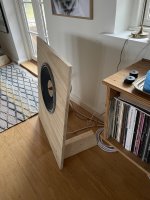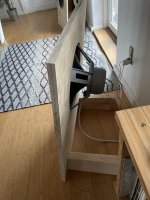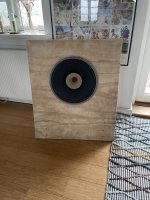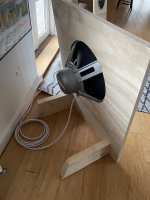Hello,
I'm looking to build a pair of open baffles using the Lii Audio F-15 full range speakers.
Actually I've already built a quick version with some plywood I had laying around. They're (HWD) 84x70x2,2 cm and not super sturdy. I'll attach some photoes ASAP.
I'm quite surprised and pleased with the sound and therefore want to optimise both their looks and their sound. I'm particularly looking fuller midrange.
So a couple of questions:
- What will a bigger baffle give me? Particularly if I make it wider? Is there a limit to how wide (and tall) it should be?
- How important is the rigidity of the baffle? 2 cm is not very thick plywood, and my baffles don't fell super stiff. What will a thick baffle yield in terms of sound improvements?
- Is there an easy-to-use program where I can calculate baffle dimensions etc.?
- Also, is it OK to use thick MDF or HDF as baffle even on bigger baffles?
Hope you can help!
Malm
I'm looking to build a pair of open baffles using the Lii Audio F-15 full range speakers.
Actually I've already built a quick version with some plywood I had laying around. They're (HWD) 84x70x2,2 cm and not super sturdy. I'll attach some photoes ASAP.
I'm quite surprised and pleased with the sound and therefore want to optimise both their looks and their sound. I'm particularly looking fuller midrange.
So a couple of questions:
- What will a bigger baffle give me? Particularly if I make it wider? Is there a limit to how wide (and tall) it should be?
- How important is the rigidity of the baffle? 2 cm is not very thick plywood, and my baffles don't fell super stiff. What will a thick baffle yield in terms of sound improvements?
- Is there an easy-to-use program where I can calculate baffle dimensions etc.?
- Also, is it OK to use thick MDF or HDF as baffle even on bigger baffles?
Hope you can help!
Malm
Hi Malm. You've got a good stat going there.
The biggest problem with OB is the loss of bass. That's why most speakers use boxes. With OB the woofer will have a rising response because of the bass loss. You have to do something to correct that rising response or your speaker will sound thin and weak. You need to bring down the mid and high response to match the bass for a natural tonal balance.
- No, there is no limit to the size of the baffle.
- A larger baffle gives you more bass and more dynamics.
- A large baffle is more efficient than a small baffle (less loss)
- Thick, stiff baffle is good. They do vibrate!
- Side wings help.
The biggest problem with OB is the loss of bass. That's why most speakers use boxes. With OB the woofer will have a rising response because of the bass loss. You have to do something to correct that rising response or your speaker will sound thin and weak. You need to bring down the mid and high response to match the bass for a natural tonal balance.
Also, for better bass and low mids, pull the baffles away from the wall. You will quickly hear the difference!
Thank you so much. That's extremely helpful👍
I should have mentioned: at the moment I'm using an active sub (Dynaudio S18) because half my listening consists of electronic music.
When you say "naturel tonal balance" that's exactly what I want! Because right now the speakers are a bit thin or even shouty.
But thank you, open baffle is super interesting and for a novice it's perfect for experimenting.
Kind regards
Malm
I should have mentioned: at the moment I'm using an active sub (Dynaudio S18) because half my listening consists of electronic music.
When you say "naturel tonal balance" that's exactly what I want! Because right now the speakers are a bit thin or even shouty.
But thank you, open baffle is super interesting and for a novice it's perfect for experimenting.
Kind regards
Malm
Hello,
baffle dimensions you can "calculate" with diffraction tool, or perhaps the other way around you can input some numbers and see what the effect of the baffle is. Diffraction tool that I'm familiar with comes with VituixCAD and there are other programs but I don't remember the names currently 🙂
If you try out a diffraction simulator you'll see there is big main diffraction hump and it moves higher in frequency with smaller baffle and lower if you enlarge the baffle. You'll also notice there is some ripple above the hump and bass tapers off below the hump. You can try offset the driver / make some asymmetry to the baffle or use minimal sized baffle to smoothen the ripple above the hump. The hump and tapering bass will always be there when the baffle is practical size so all you can do is move it up or down in frequency and this would affect how it sounds along with the baffle resonating and what not. Even though it is a very simple construct there might be many things at play that make one baffle size sound a bit off but the other can sound fine.
What you might be able to do with practical sized baffles and adjusting height (of the baffle and driver) is try position the hump to a frequency where it plays nicely with room reflections. Pano already mentioned distance to walls. Anyway, it all depends on your room and positioning of the speakers and the listening position so all you can do is experiment and listen. I would use any baffle, and if it feels it doesn't sound good no matter what the positioning is then try see if there is resonance problem and make it aesthetically nice.
Here is attached quick diffraction simulation of ideal baffle with ideal 15" transducer on it, similar size to your systme. Diffraction hump is here between ~150-600Hz. The other images illustrate with simple isolated floor bounce added in with driver center height of 60cm and 80cm of the floor with 3m listening distance, the orange line on the graph is estimated response at listening position showing resulting interference pattern between direct and reflected sound.
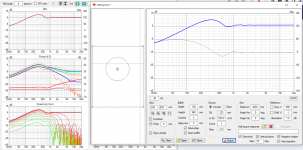
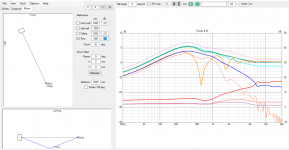
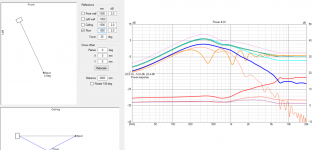
First thing that caught the eye is that dip on the orange line looks less severe as if it is aligned with the hump. Perhaps more importantly the hump around 300Hz is less on the orange line, as dips are less audible than boosts. Basically the diffraction hump can make wooly or boxy sound to the speaker if boosting the low mids, which the floor bounce can perhaps balance out some. But as I've never heard the speaker or know nothing about the driver or your room it is all speculation. Hope it helps you to find your own way through it. Keep it simple and fun!🙂
Disclaimer, I've yet to build open baffle speaker and the post is reasoning based on some speaker builds, sims and what I've read on the forums.
baffle dimensions you can "calculate" with diffraction tool, or perhaps the other way around you can input some numbers and see what the effect of the baffle is. Diffraction tool that I'm familiar with comes with VituixCAD and there are other programs but I don't remember the names currently 🙂
If you try out a diffraction simulator you'll see there is big main diffraction hump and it moves higher in frequency with smaller baffle and lower if you enlarge the baffle. You'll also notice there is some ripple above the hump and bass tapers off below the hump. You can try offset the driver / make some asymmetry to the baffle or use minimal sized baffle to smoothen the ripple above the hump. The hump and tapering bass will always be there when the baffle is practical size so all you can do is move it up or down in frequency and this would affect how it sounds along with the baffle resonating and what not. Even though it is a very simple construct there might be many things at play that make one baffle size sound a bit off but the other can sound fine.
What you might be able to do with practical sized baffles and adjusting height (of the baffle and driver) is try position the hump to a frequency where it plays nicely with room reflections. Pano already mentioned distance to walls. Anyway, it all depends on your room and positioning of the speakers and the listening position so all you can do is experiment and listen. I would use any baffle, and if it feels it doesn't sound good no matter what the positioning is then try see if there is resonance problem and make it aesthetically nice.
Here is attached quick diffraction simulation of ideal baffle with ideal 15" transducer on it, similar size to your systme. Diffraction hump is here between ~150-600Hz. The other images illustrate with simple isolated floor bounce added in with driver center height of 60cm and 80cm of the floor with 3m listening distance, the orange line on the graph is estimated response at listening position showing resulting interference pattern between direct and reflected sound.



First thing that caught the eye is that dip on the orange line looks less severe as if it is aligned with the hump. Perhaps more importantly the hump around 300Hz is less on the orange line, as dips are less audible than boosts. Basically the diffraction hump can make wooly or boxy sound to the speaker if boosting the low mids, which the floor bounce can perhaps balance out some. But as I've never heard the speaker or know nothing about the driver or your room it is all speculation. Hope it helps you to find your own way through it. Keep it simple and fun!🙂
Disclaimer, I've yet to build open baffle speaker and the post is reasoning based on some speaker builds, sims and what I've read on the forums.
Some thoughts on shouty / thin comment of yours: you are losing the lows for the open baffle configuration and this would make the low / high balance off without compensation. In addition 15" ideal driver beams above 1kHz but a real world driver has all kinds of cone resonances / breakup going in addition which makes ragged response to any axis, whizzer cone and what not, trying to make some kind of nice response to some axis. All you can do is to change the toe-in, try find some balanced sounding angle. You can try EQ on it but you can never correct more than one axis and this is what makes sweet spot very small on full range speakers. You just gotta find where it is, the balanced sounding listening angle. Also positioning of the speakers and you as listener in room affects the perceived balance.
Multi-way speaker can have controlled directivity and thus bigger sweetspot, and less resonances since no necessity to work the drivers up to breakup frequency. Main difference between multi-way and single driver fullrange speaker is possibility to separate concerns, optimize things without compromise on others. One can have bass without beaming treble for example, and big sweetspot, crossover before resonances etc. Comes with some other compromises and for example shouting and thin could be description of poorly designed multi-way as well. As you see from the graphs on my previous post even ideal 15" ob fullrange driver system the response is not balanced an needs compensation (more bass), and as it beams like lazer the highs are heard only at on-axis. If you are off-axis of such uncompensated system you would only get about the AM radio frequencies, so try some good old smiley face EQ on it.
Anyway, just matter of finding balanced sounding positioning like with any speaker but on this kind of system this would be very important. If it still doesn't sound right no matter what perhaps the drivers are not for your taste and some other drivers or other kind of system would work better. Never know before trying!🙂
Multi-way speaker can have controlled directivity and thus bigger sweetspot, and less resonances since no necessity to work the drivers up to breakup frequency. Main difference between multi-way and single driver fullrange speaker is possibility to separate concerns, optimize things without compromise on others. One can have bass without beaming treble for example, and big sweetspot, crossover before resonances etc. Comes with some other compromises and for example shouting and thin could be description of poorly designed multi-way as well. As you see from the graphs on my previous post even ideal 15" ob fullrange driver system the response is not balanced an needs compensation (more bass), and as it beams like lazer the highs are heard only at on-axis. If you are off-axis of such uncompensated system you would only get about the AM radio frequencies, so try some good old smiley face EQ on it.
Anyway, just matter of finding balanced sounding positioning like with any speaker but on this kind of system this would be very important. If it still doesn't sound right no matter what perhaps the drivers are not for your taste and some other drivers or other kind of system would work better. Never know before trying!🙂
Last edited:
Decware is selling the plans for your OB with F15 for $30, you might find it interesting:
https://www.decware.com/newsite/ZMS2.html
https://www.decware.com/newsite/images/ZF15Mplans.png
https://www.decware.com/newsite/ZMS2.html
https://www.decware.com/newsite/images/ZF15Mplans.png
Could you elaborate on this please - it's not something I have ever come across or understand.A larger baffle gives you .... more dynamics.
Here is roughly decware sized ideal baffle and driver for comparison. Although it is somewhat bigger the difference is not that much compared to the current baffle because the increase is not much in percentage. Practically no difference between the ideal case simulations at least. Double the dimensions to ~1.5m width and ~2m height to get the hump octave lower but that is not very practical anymore 🙂
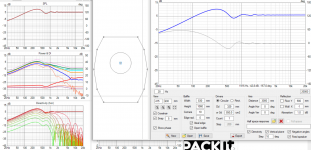
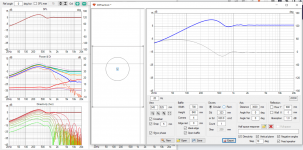
What I'd do first before thinking making new baffle is just play with the placement. Play also with height, put brick or two to elevate some and see how it affects the tonality.


What I'd do first before thinking making new baffle is just play with the placement. Play also with height, put brick or two to elevate some and see how it affects the tonality.
Last edited:
Hi Malm
You can also check the JE Labs Open Baffle. It's an old design that works well. Same dimensions as Wharfedale SFB and Quad ESL57.
http://jelabsarch.blogspot.com/2012/06/open-baffle.html?m=1
Many projects in the web. You can fix a pair from one sheet 2440x1220mm.
You can also check the JE Labs Open Baffle. It's an old design that works well. Same dimensions as Wharfedale SFB and Quad ESL57.
http://jelabsarch.blogspot.com/2012/06/open-baffle.html?m=1
Many projects in the web. You can fix a pair from one sheet 2440x1220mm.
I like this design. Don't be afraid to try coupling the baffles to the side walls for extended bass.Hi Malm
You can also check the JE Labs Open Baffle. It's an old design that works well. Same dimensions as Wharfedale SFB and Quad ESL57.
http://jelabsarch.blogspot.com/2012/06/open-baffle.html?m=1
Many projects in the web. You can fix a pair from one sheet 2440x1220mm.
More dynamics with a larger baffle is a subjective assessment. Perhaps it could be measured, but I don't know how off the top of my head.Could you elaborate on this please - it's not something I have ever come across or understand.
IME, the larger baffle means a more efficient bass. When the woofer isn't straining so hard to produce the low notes, the sound can feel more dynamic. It may actually be more dynamic, as the larger surface area means less front to back cancellation, and therefore less woofer excursion for a given SPL.
In some ways it's like a 15" woofer and an 8" woofer producing the same bass notes. One is more likely than the other to produce a clean impact.
Increasing baffle size will improve efficiency and bass extension but not necessarily the mids and highs. I would start getting a measurement microphone to understand how your current response is. If you drive via PC you could try EQ software to flatten response somewhat and boost the bass. And check the effect of various wing extensions and/or baffle sizes. Simulation is possible with Edge and Boxsim. If you have a bit more budget you could try DSP solutions, e.g. fusion plate amps. You could add one or two drivers over time, e.g. a mid, tweeter or super tweeter. Or add a Heil AMT on top to open up mid and highs a lot starting from 1-2 kHz...
Enough options, have fun! 🙂
Enough options, have fun! 🙂
It is a term frequently used in both music and audio playback. Are you not familiar with it?what you specifically mean by 'dynamic'...
https://www.pcmag.com/encyclopedia/term/dynamic-speaker
https://ask.audio/articles/mixing-concepts-what-is-dynamics-why-you-should-care
https://www.whatsbestforum.com/threads/what-does-a-dynamic-sounding-speaker-mean.28761/
Increasing baffle size and using same driver with no or same EQ, will only change tonal balance by increasing bass output spl a little. Dynamics of sound/music won't change at all. Music might sound like having more impact, punch, because eg. kickdrum and bass guitar range gets lifted.
Malm7913, please study some basic physics of sound reproduction! A measurement microphone/system and some learning of how to use it will help you to "see" and understand what changes actually happen when you modify or make speakers.
Some good web pages regarding dipole/open baffle speakers
http://www.dipolplus.de/thema11.php
http://musicanddesign.speakerdesign.net/tech.html
https://www.linkwitzlab.com/frontiers.htm
https://ask.audio/articles/mixing-concepts-what-is-dynamics-why-you-should-care
https://www.whatsbestforum.com/threads/what-does-a-dynamic-sounding-speaker-mean.28761/
Increasing baffle size and using same driver with no or same EQ, will only change tonal balance by increasing bass output spl a little. Dynamics of sound/music won't change at all. Music might sound like having more impact, punch, because eg. kickdrum and bass guitar range gets lifted.
Malm7913, please study some basic physics of sound reproduction! A measurement microphone/system and some learning of how to use it will help you to "see" and understand what changes actually happen when you modify or make speakers.
Some good web pages regarding dipole/open baffle speakers
http://www.dipolplus.de/thema11.php
http://musicanddesign.speakerdesign.net/tech.html
https://www.linkwitzlab.com/frontiers.htm
I am, I was trying to understand your own specific definition, and how this characteristic could be altered by changing baffle size.It is a term frequently used in both music and audio playback. Are you not familiar with it?
I understand it to mean a variation in sound level - the dynamic range, if you will. I can understand that the frequency response will be modified by changes in baffle size, shape, and driver positioning. If the LF region has to be EQ'd to produce a given LF extension then headroom/dynamic range will be reduced compared with a larger baffle requiring no EQ. Is this the effect to which you are referring?
Thank you all. I’m trying to digest all the great advice. Will report back when I‘ve finished the new baffles. I’ll say this though: I just inserted the Schiit Loki equaliser and that took care of a large portion of my caveats. A healthy boost to bass and lower midrange did wonders.
Thanks again
Thanks again
- Home
- Loudspeakers
- Full Range
- Open Baffle
